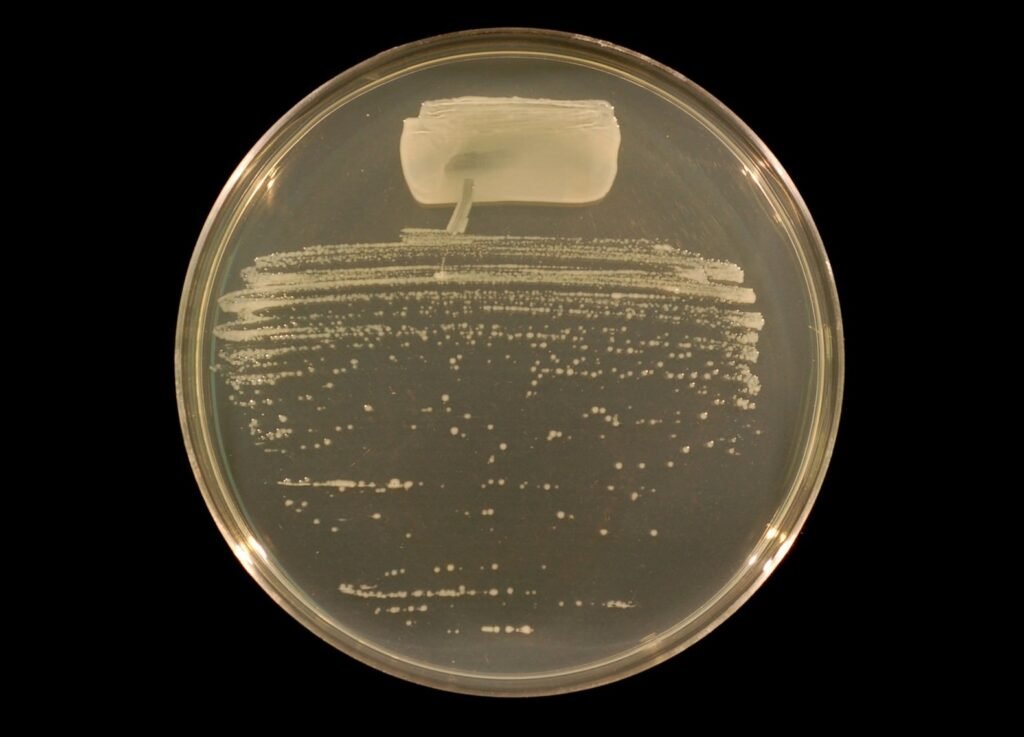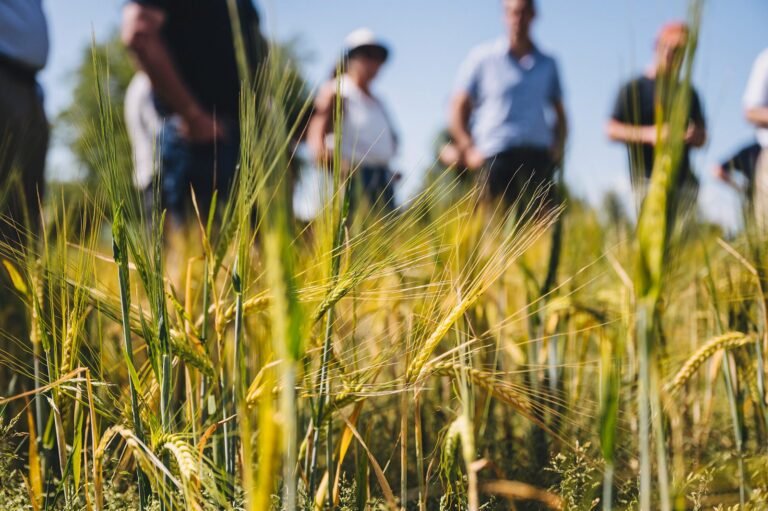When it comes to growing healthy legumes without relying on chemical fertilisers, Rhizobium bacteria are true game-changers. These tiny soil microbes form a natural alliance with legume roots, fixing nitrogen straight from the air and turning it into a form plants can use. The result? Stronger crops, richer soils, and lower fertiliser bills.
Tiny bacteria, big savings!
Forget expensive nitrogen fertilisers. Let nature do the work with Rhizobium, the root-dwelling microbes that fix nitrogen for your peas, beans, and clover.
Boost yields, cut costs, and build healthier soil, all thanks to a microscopic ally that’s been working underground for millions of years.
But here’s the catch: Rhizobium is powerful – and picky.
This helpful bacterium doesn’t like stress. Acidic soils, drought, heatwaves, or even too much salt can reduce its ability to form nodules and do its job. That’s why knowing how it works, and what it needs, is key to getting the most out of it.
In this post, we’ll explore:
- Why Rhizobium is so valuable for farmers and the planet,
- What factors limit its performance,
- And how to support it in real-world growing conditions.
Whether you’re a regenerative grower, soil consultant, or just curious about nature’s own fertiliser factory, you’re in the right place.
1. What Is Rhizobium and Why Does It Matter?
Rhizobium is a genus of soil-dwelling bacteria that plays a vital role in natural nitrogen cycling. Unlike many microbes, Rhizobium doesn’t just float around in the soil, it forms a symbiotic relationship with legume plants like peas, beans, clover, and alfalfa. Together, they form root nodules, which act like natural nitrogen factories.
Inside these nodules, Rhizobium converts atmospheric nitrogen (N₂) into ammonia (NH₃), a form of nitrogen that plants can absorb and use to grow. This process is called biological nitrogen fixation. It’s one of the most sustainable ways to enrich soil without adding synthetic fertilisers.
Why does this matter?
Because nitrogen is essential for plant growth, but producing chemical nitrogen fertilisers is expensive, energy-intensive, and contributes to pollution. With Rhizobium, farmers can:
- Reduce fertiliser use,
- Improve soil health,
- Lower environmental impact.
In fact, research from the AHDB and Frontiers in Sustainable Food Systems confirms that Rhizobium is a cornerstone of low-input, high-efficiency legume production. It’s widely used in organic farming and regenerative agriculture for precisely this reason.
But while Rhizobium is impressive, its benefits depend on the right conditions, which brings us to the next point.
Rhizobium at a Glance
Main Role: Fixes atmospheric nitrogen inside legume root nodules
Best for: Peas, beans, lentils, clover, alfalfa
Benefits: Increases yields, reduces fertiliser use, improves soil
Sensitive to: Low pH (<6), high salinity, drought, and extremes of temperature
Symbiosis: Must form root nodules to be effective
Needs: Moist soil, good pH balance, and minimal synthetic nitrogen
Works well with: Bacillus subtilis and regenerative practices
Soil hero: Vital for natural nitrogen cycling and legume performance
2. How Rhizobium Works – From Soil to Root Nodule
To truly understand the power of Rhizobium, we need to explore how it actually helps plants. The journey begins underground, in the soil, where these bacteria live freely. When they sense nearby legume roots, Rhizobium gets to work.
Step-by-Step: The Symbiotic Process
1. Detection and Signalling:
First, legume roots release specific compounds (called flavonoids) into the soil. These act like invitations, attracting Rhizobium bacteria.
2. Nod Factor Activation:
In response, Rhizobium produces signaling molecules known as Nod factors. These signals trigger changes in the plant root cells, starting the formation of root nodules.
3. Root Invasion:
Then, the bacteria enter the root through small infection threads. Inside the root cortex, they begin colonising the developing nodule.
4. Nitrogen Fixation Begins:
Once inside the nodule, Rhizobium converts atmospheric nitrogen (N₂) into ammonia (NH₃), a usable nutrient for the plant. In return, the plant provides carbohydrates as fuel for the bacteria.
This partnership is highly efficient. According to Oxford Biology, a single hectare of well-nodulated legumes can fix over 100 kg of nitrogen per growing season, reducing the need for synthetic fertilisers significantly.
However, this amazing process depends on many environmental factors. In the next section, we’ll explore why even this powerful microbe needs the right conditions to succeed.
3. The Sensitivity of Rhizobium: Why Conditions Matter
While Rhizobium offers powerful benefits, it is not invincible. In fact, its performance depends heavily on environmental conditions. Without the right soil balance, this nitrogen-fixing hero can quickly lose its edge.
Soil pH: A Delicate Balance
To begin with, Rhizobium thrives best in neutral to slightly acidic soils, ideally between pH 6.0 and 6.8. However, in acidic soils (below pH 5.5), their survival rate drops. This is because acid stress hampers both their growth and their ability to form root nodules. Therefore, farmers working with acidic soils often need to apply lime to correct pH and support Rhizobium activity.
Temperature Matters
Next, temperature plays a key role. Rhizobium generally prefers soil temperatures between 25°C and 30°C. Although some strains show moderate resilience to cold or heat, extremes can delay or completely stop nodulation. Consequently, sowing legumes during periods of extreme weather may lead to poor nitrogen fixation.
Moisture and Drought Stress
Moreover, moisture is essential for Rhizobium survival. These bacteria depend on water to move through soil and reach root zones. During droughts, low water availability not only limits bacterial mobility but also stresses the host plant, making the symbiosis less effective.
Salinity: A Hidden Threat
High salt levels in soil also affect Rhizobium performance. Salinity interferes with the signalling process between roots and bacteria, disrupting the formation of nodules. As a result, nitrogen fixation may drop sharply, especially in arid or coastal farming areas.
Nutrient Competition
Interestingly, too much nitrogen in the soil can actually reduce Rhizobium’s role. Plants supplied with abundant synthetic nitrogen tend to rely less on their bacterial partners. Thus, applying too much fertiliser may prevent nodulation altogether.
In short, Rhizobium is a powerful partner, but a sensitive one. Fortunately, through soil management, smart crop planning, and the use of resilient bacterial strains, farmers can overcome these challenges. Next, let’s look at the tangible benefits this bacterium offers when conditions are just right.

4. Real Benefits for Legume Farmers
When soil conditions are favourable, Rhizobium bacteria can completely transform legume cultivation. Their symbiotic relationship with crops like beans, peas, lentils, and clover offers both ecological and economic advantages.
Natural Nitrogen Fixation = Lower Fertiliser Costs
First and foremost, Rhizobium bacteria convert atmospheric nitrogen into a usable form for plants, all without synthetic fertilisers. Because of this, farmers can reduce their dependence on chemical nitrogen inputs. Over time, this translates into major cost savings, especially for large-scale legume growers.
Better Soil Health Over Time
In addition, the process of biological nitrogen fixation enriches the soil. Unlike chemical fertilisers, which can lead to nutrient imbalances or runoff, Rhizobium contributes to long-term soil fertility. As a result, farmers notice improved yields not just for legumes, but also for the crops that follow.
Stronger Plants, Higher Yields
Well-nodulated plants tend to grow stronger and more vigorously. This is because they receive a steady supply of nitrogen right where they need it, in the root zone. In many cases, farmers report increased pod numbers, healthier foliage, and overall higher yields in Rhizobium-inoculated crops.
Sustainability Bonus
Moreover, using Rhizobium supports eco-friendly farming. It helps lower greenhouse gas emissions by reducing the production and use of synthetic fertilisers. Additionally, it decreases nitrogen runoff, which often leads to water pollution. For farms aiming for regenerative or organic certification, these are significant benefits.
In short, when farmers invest in healthy soil biology, and create the right conditions, Rhizobium repays them many times over. Coming up next: we’ll explore why it sometimes fails and how to prevent that.
5. When Nodulation Fails – And What to Do About It
Although Rhizobium offers huge benefits, things don’t always go according to plan. In fact, failed nodulation is a common issue, especially when soil conditions aren’t ideal. Understanding the causes can help farmers take quick, practical steps to fix the problem.
What Causes Nodulation to Fail?
Several factors can prevent Rhizobium from forming healthy root nodules:
- Low soil pH: If the pH falls below 6.0, Rhizobium struggles to survive and colonise roots. Acidic soils reduce its effectiveness.
- High soil temperatures: These bacteria prefer moderate temperatures (25–30°C). Excessive heat can reduce both survival and nitrogen fixation..
- Drought or dry conditions: Lack of moisture stresses both the bacteria and the host plant, making nodulation less likely.
- Salinity and heavy metals: Salty soils or contamination can inhibit bacterial growth and nodulation.
- Pesticide residues: Some pesticides, especially seed treatments, may interfere with Rhizobium activity or reduce microbial diversity.
- Excess nitrogen in soil: Surprisingly, when nitrogen levels are already high, plants stop cooperating with Rhizobium. This shuts down nodule formation entirely.
How to Fix It
The good news? Most of these issues can be addressed.
- Adjust pH: Lime acidic soils to reach a pH of 6.0–6.8.
- Manage irrigation: Maintain consistent moisture without waterlogging.
- Avoid over-fertilising: Use nitrogen fertilisers carefully, and preferably at reduced rates if inoculating with Rhizobium.
- Choose the right strain: Select Rhizobium varieties adapted to local conditions. Some strains show better tolerance to salinity or low pH.
- Use microbial blends: Combining Rhizobium with stress-tolerant helpers like Bacillus subtilis may improve success rates under less-than-ideal conditions.
If nodulation fails once, don’t give up. Instead, use the failure as feedback. Adjust your soil management strategy, choose better microbial allies, and try again, the benefits are worth it.

6. Integrating Rhizobium Into Modern Farming
In today’s world of sustainable agriculture, Rhizobium offers a simple, natural way to improve soil fertility, especially when growing legumes. However, making the most of it requires good planning and smart integration.
Where Does Rhizobium Fit Best?
Rhizobium works exceptionally well in fields where legumes like peas, beans, clover, or alfalfa are part of the rotation. These crops form a symbiotic relationship with the bacteria, turning atmospheric nitrogen into plant-available nutrients, right inside their roots.
In addition, Rhizobium helps:
- Rebuild nitrogen levels after intensive cereal or maize cropping.
- Reduce the need for chemical fertilisers, lowering both costs and emissions.
- Restore soil biodiversity after years of conventional farming.
Practical Application Tips
For the best results, consider the following:
- Inoculate seeds or soil: Apply Rhizobium as a seed coating or directly into the soil before sowing. This ensures contact between the bacteria and the young roots.
- Avoid using incompatible pesticides: Choose treatments that won’t kill the microbial inoculant.
- Time fertiliser use: If you must apply nitrogen, do it carefully. Too much too soon will reduce the plant’s interest in partnering with Rhizobium.
- Use companion microbes: Pairing Rhizobium with beneficial bacteria like Bacillus subtilis can boost performance under environmental stress.
A Valuable Tool in Regenerative Systems
Rhizobium is more than a microbial input, it’s a powerful ally in regenerative systems. It helps close the nitrogen loop, reduces dependency on fossil fuel-based fertilisers, and improves yields in a way that supports soil health long term.
In combination with cover crops, crop rotations, composting, and reduced tillage, Rhizobium contributes to the kind of resilient farming the world urgently needs.
Small Microbes, Big Impact
Rhizobium bacteria may be tiny, but their contribution to sustainable agriculture is massive. By naturally fixing atmospheric nitrogen in legumes, they reduce the need for chemical fertilisers, improve soil health, and support crop yields. However, they’re sensitive to pH, salinity, moisture, and temperature. That means success depends on good soil management and the right environmental conditions. Still, when used wisely, Rhizobium can become a powerful part of any regenerative farming system.
Let’s Fix Nitrogen Naturally
Want to build healthier soil and grow better crops with fewer chemicals? Start with the power of Rhizobium. Whether you’re growing beans, clover, or alfalfa, these microbes can work with your plants, not against them. Contact us today to find the right microbial solution for your farm.







